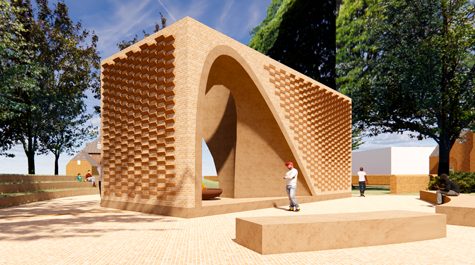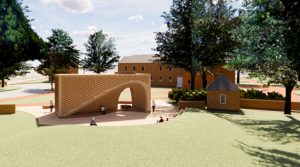
The Lemon Project held a panel discussion Tuesday, Aug. 25 to update students, faculty and staff at the College of William and Mary on progress made on the proposed Memorial to the African Americans Enslaved by William and Mary. Construction on the memorial, for which a concept was selected in April 2019, is slated to begin in January 2021.
The final design was presented to the Board of Visitors earlier this week as described in a press release from the College. The memorial has successfully reached its $2 million fundraising goal, half of which was raised by donations from alumni and community members, with all private donations matched dollar-for-dollar by the BOV.
Discussion around erecting a memorial began with a course in 2014 taught by Director of the Lemon Project and history professor Jody Allen Ph.D ’09 and art senior lecturer Ed Pease. Students in the class were asked to develop a memorial concept as a final project. Soon thereafter, the Lemon Project Committee on Memorialization was formed to brainstorm ideas for a Memorial to the Enslaved on campus.
“As we finished the class and decided to create this committee on memorialization, the big question was, ‘how does this work?’,” Pease said. “How do we choose someone or how do we find the right person to design it? It was a pretty unanimous decision early on to do a competition.”
The committee hosted an international competition, inspired by the one conducted for the Vietnam Veterans Memorial in Washington D.C. It received 80 submissions from 16 states and four continents. In April 2019, the committee announced that the winning design was “Hearth” by William Sendor ’11.
“Hearth” is intended to invoke a brick fireplace. The names of the enslaved, or citations if a name is unknown, will be inscribed on bricks that protrude from the structure.
Allen welcomed student participation in the ongoing research process to uncover more names or citations of the enslaved.
“One of the things we’re still doing is looking for as many names of the enslaved as we can find. The names will actually go on the monument. We’re up to 186 names or citings because a lot of times people are named for a skill. We’re finding some almost every time someone goes into the archives to look. There are opportunities for student research. We want student input.”
“One of the things we’re still doing is looking for as many names of the enslaved as we can find,” Allen said. “The names will actually go on the monument. We’re up to 186 names or citings because a lot of times people are named for a skill. We’re finding some almost every time someone goes into the archives to look. There are opportunities for student research. We want student input.”
Once the initial concept was selected, the building committee met with numerous architectural firms, who presented ideas on how to realize Sendor’s vision. The committee selected Baskervill, an architectural firm based in Richmond, Va.
“I know we’ve kind of been quiet and invisible so it looks like we haven’t been working, but we really have been working, it’s just behind the scenes,” Chief Diversity Officer Chon Glover said.
Principal Architect at Baskervill Burt Pinnock said that once construction begins, it is projected to last nine to 11 months. The 20-ft-tall memorial will be located on the College’s historic campus on the south side of the Sir Christopher Wren Building, breaking one of the walls surrounding the campus. It will be the first new construction on the historic campus since the Rockefeller renovations of 1932.

Executive Director of Historic Campus Susan Kern noted the importance of the memorial’s placement.
“Strategically, it breaks through a 1932 wall that was put there to define the boundaries of W&M’s historic campus,” Kern said. “The wall came up as a symbol to the community that there were walls around W&M to keep them out. One of the things that this memorial does is break through that wall and impose an intervention into how we tell history here. It is challenging the visual order of campus that has been in place for almost 100 years. It is that important to us.”
The memorial will also stand directly across Jamestown Road from the College’s admissions office. The office, which is a starting point for campus tours, marks a central location that receives significant foot traffic.
“We’re hoping that the Memorial will serve as a new pathway and a new welcoming to the campus. We’re hoping this whole area will be a gateway to welcoming people in to learning about our history but also to be reverent and respectful of the sacred space.”
“We’re hoping that the Memorial will serve as a new pathway and a new welcoming to the campus,” Glover said. “We’re hoping this whole area will be a gateway to welcoming people in to learning about our history but also to be reverent and respectful of the sacred space.”
The committee hopes the memorial will act as not only a site of remembrance, but also a site of gathering. Allen said that she envisions the space as a new site of tradition for students, one for gatherings, studying, poetry readings and ceremonies. For descendants of those who were enslaved by the College, Allen said it will be a space for them, too.
Pinnock said that the memorial will include details such as lighting and electricity to ensure flexibility for the space. Though they did not offer specifics on programming and policy for the use of the memorial, the panelists emphasized that the memorial would be more than just a structure.
“The entire process has also been backed by the idea that the memorial is not the only thing,” Kern said. “A physical memorial is only part of scholarships, of courses, of endowed professors, of institutes that study this history. It is the beginning of memorialization, but it certainly isn’t the end of this conversation.”
Pease expanded on the educational programming surrounding the memorial, mentioning that the committee hopes to put together an exhibition that showcases all the submissions that were received in the competition. He also noted the significant number of tourists and visitors that will visit the memorial.
“So often, when a visitor or a tourist comes to a place like W&M, it is so easy to see it as this beautiful park-like campus and wonderful buildings. The memorial weaves more of a complete history together.”
“So often, when a visitor or a tourist comes to a place like W&M, it is so easy to see it as this beautiful park-like campus and wonderful buildings,” Pease said. “The memorial weaves more of a complete history together.”
The panel received some questions regarding the memorial’s juxtaposition with other monuments on campus, some of which depict slave owners such as Thomas Jefferson and James Monroe. Pinnock responded by arguing that the structural elements of injustice can be seen throughout campus, not simply in the other statues.
“The call to action here is to ask what is the structural bias in everything we see, touch and do, and the places we inhabit and the things that we make and the way that we speak,” Pinnock said. “Understand that to understand better our entire environment. There’s no reason why a memorial of this nature should be asked to speak to one of the others.”
With historic campus remaining largely unchanged for centuries, the panelists emphasized both the necessity of the memorial as well as the fact that it is long overdue.
“The campus right now reflects the population, in terms of the iconography, of the 18th and 19th centuries,” Allen said. “The people on campus now — it’s a much more diverse group of people and the landscape should reflect that. It says, ‘these 186 people who lived and toiled at W&M for no compensation for 172 years must be remembered.’ That’s what this does — it remembers them; it acknowledges them; it humanizes them.”
